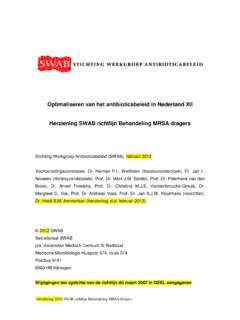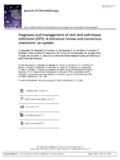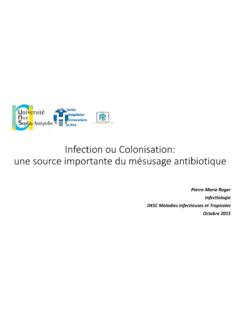Transcription of Antibacterial therapy of adult patients with Sepsis - …
1 swab richtlijn Sepsis December 2010 swab guidelines for Antibacterial therapy of adult patients with Sepsis Dutch Working Party on Antibiotic Policy ( swab ) Preparatory Committee swab board, Chair Coordinator Dutch Society for Infectious Diseases (VIZ) Dutch Society for Internal Medicine (NIV) Dutch Society for Microbiology (NVMM) Dutch Association of Hospital Pharmacists (NVZA) Dutch Society for Surgery (NVH) Dutch Society for Intensive Care (NVIC) Dutch Society for Haematology (NVvH) Prof. dr Gyssens Bax Dr Schippers, S.
2 Van Assen Dr Schippers, S. van Assen Dr Ang, Dr P. Sturm Dr van der Meer Dr Boermeester Dr Schouten, Dr P. Pickkers Dr Janssen Dr Blijlevens 2010 swab Secretariaat swab 10 AMC Afd. Infectieziekten, Tropische Geneeskunde en AIDS F4-217 Postbus 22660 1100 DD AMSTERDAM Tel 020 566 43 80 Fax 020 697 22 86 2 swab richtlijn Sepsis December 2010 Table of contents Chapter 1 Introduction General introduction Scope of the guideline Definitions Key questions Chapter 2 Aetiology and resistance patterns of microorganisms causing Sepsis 10 Chapter 3 Combination therapy versus monotherapy for Sepsis Chapter 4 Selection of antimicrobial drugs for empirical therapy of Sepsis Chapter 5 Selection of Antibacterial
3 Drugs for therapy in documented S. aureus Sepsis Chapter 6 Dosage of Antibacterial drugs for therapy of Sepsis Chapter 7 Duration of Antibacterial drugs for therapy of Sepsis 20 Chapter 8 Switching intravenous to oral Antibacterial therapy for Sepsis Chapter 9 Timing of starting Antibacterial therapy for Sepsis and sampling for blood cultures 3 swab richtlijn Sepsis December 2010 Chapter 1 Introduction General introduction The Dutch Working Party on Antibiotic Policy (Stichting Werkgroep Antibioticabeleid, swab ) was founded in 1996 as an initiative of the Dutch Society for Infectious Diseases (VIZ), the Dutch Society for Microbiology (NVMM), and the Dutch Association of Hospital Pharmacists (NVZA).
4 swab develops national guidelines for the use of antibiotics in hospitalised patients in order to optimise the quality of prescribing, thus, contributing to the containment of antimicrobial drug costs and resistance. 10 The first swab guideline on Sepsis was published in 1999. An update was considered timely to comply with the revised procedures of swab guideline development. This update was developed according to the Evidence Based Guideline Development method (EBRO) (1). The AGREE criteria ( ) provided a structured framework both for the development and the assessment of the draft guideline.
5 A systematic search of the literature was performed according to eight key questions concerning the antibiotic treatment of adult patients with Sepsis . The databases from Pubmed and the Cochrane Library were used as main resources. In the separate literature searches, no time limit was chosen and the included studies go as far back as 1976. Conclusions were drawn, completed with the specific level of evidence, 20 according to the grading system adopted by swab (Table 1). Subsequently, specific recommendations were formulated. Each key question will be answered in a separate chapter.
6 Scope of the guideline This guideline concerns antimicrobial therapy in all adult patients with Sepsis . The performed literature searches included studies on adult patients only. Therefore, this guideline can not indiscriminately be applied to children with Sepsis . In addition, this guideline does not cover the following: Other treatment components of Sepsis such as volume resuscitation, inotropics, corticosteroids and activated protein C 30 Antibiotic therapy of Sepsis associated with indwelling intravascular devices which are not removed (tunnelled catheter or port-a-cath) and which need a different approach.
7 A recent international guideline is available (2). Diagnostic measurements, such as the use of biomarkers For this update, the structure of the original guideline was predominantly followed. A reasonable distinction was made between patients on the basis of immunological status (neutropenic versus non-neutropenic) and the setting in which Sepsis was acquired (community-acquired, nosocomial acquired). This guideline focuses on empirical antimicrobial therapy for Sepsis with no obvious site of infection at the time of presentation as well as Sepsis with a probable/suspected site of infection.
8 In case of Sepsis and community-acquired 40 pneumonia (CAP), urosepsis and Sepsis and candidemia and Sepsis and meningitis (draft), we refer to existing swab guidelines ( ). 4 swab richtlijn Sepsis December 2010 This national guideline is a framework for the target users who are members of antibiotic committees of hospitals and who should adapt the recommendations according to local susceptibility patterns and formulary strategies. Definitions Sepsis There has been a lot of debate on the appropriate definition of Sepsis since its original formulation in 1992 (3).
9 However, no generally accepted alternative definition has been acknowledged. In this guideline, the preparatory committee agreed to adopt the following definition of Sepsis : Sepsis is considered present if an infection is suspected or proven and two or more of the following criteria are met: tachycardia (>90/min), tachypnea (>20/min), fever (> C) or temperature < C, leucocytosis (>12x109/l) or leucopenia (<4x109/l), >10% immature (band) forms. Severe Sepsis is defined as Sepsis associated with organ dysfunction, hypoperfusion, or hypotension.
10 Septic shock is diagnosed when hypotension persists despite adequate fluid resuscitation or when perfusion abnormalities occur. This guideline focuses on bacterial and fungal infections associated with Sepsis . Other relevant definitions Bloodstream infection (bacteraemia) The presence of bacteria in the blood as demonstrated by culture. 10 Neutropenia Neutropenia is defined as an absolute neutrophil count of < x 109/l (500 cells/mm3) or a count of < x109/l (1000 cells/mm3) with a predicted decrease to < x 109/l (500 cells/ mm3) (4).




